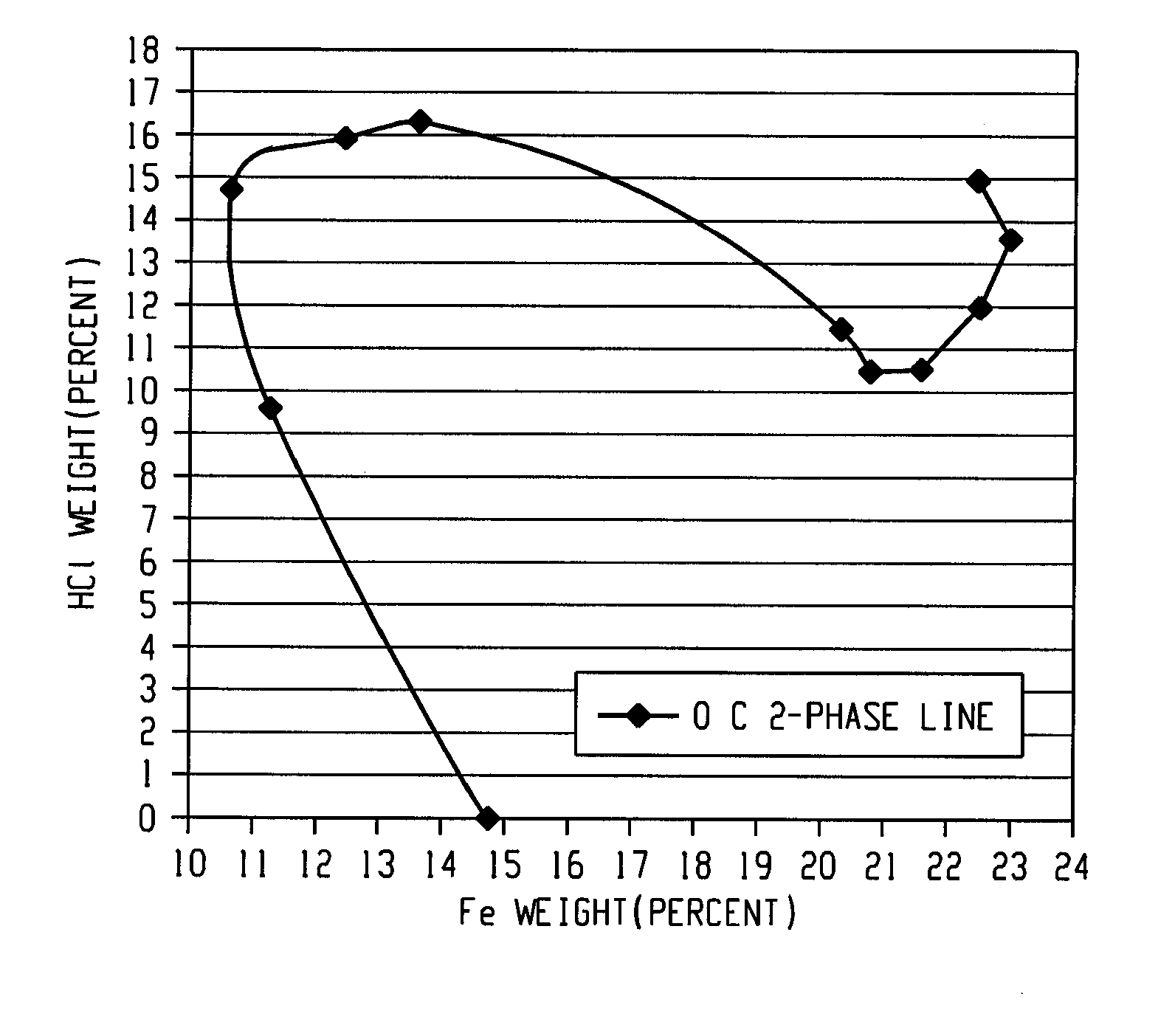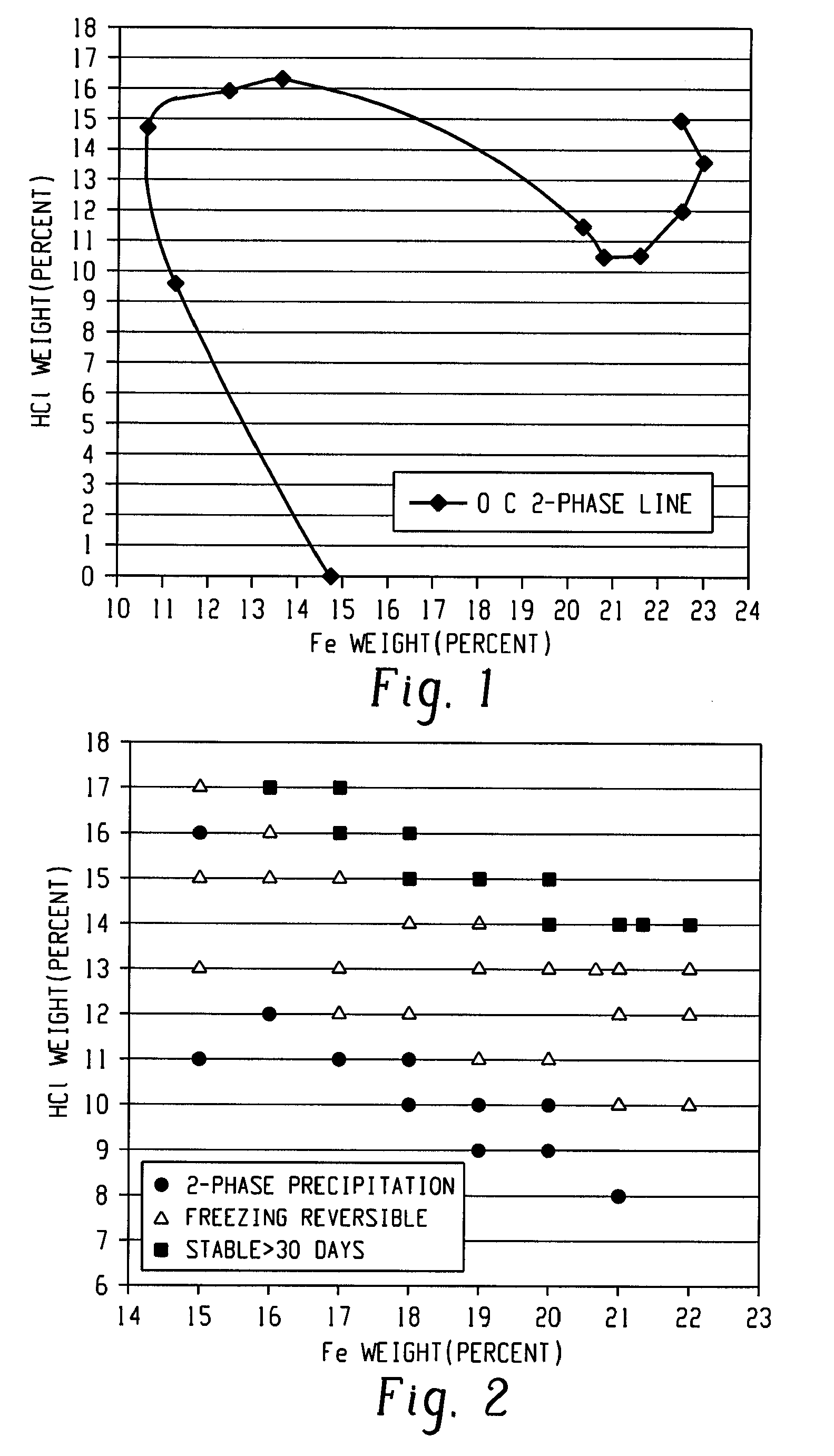Processes For Making Stable Ferric Chloride Solutions
- Summary
- Abstract
- Description
- Claims
- Application Information
AI Technical Summary
Benefits of technology
Problems solved by technology
Method used
Image
Examples
example 1
[0036]In this example, a ferric chloride solution having a 13.5 weight percent iron content was evaporated in a reactor to provide a concentrated ferric chloride solution having an iron content of 23.1 weight percent. Gaseous HCl was then bubbled into four liters of the iron concentrated ferric chloride solution for a period of time in order to produce a 20 weight percent iron concentrated ferric chloride solution with 13.8 weight percent HCl. An increase in temperature was observed due to dissolution enthalpy from the gaseous HCl. The ferric chloride solution behaved as a hydrochloric acid solution when absorbing gas and a decreased boiling temperature was observed with increasing HCl concentration.
example 2
[0037]In this example, different iron-containing materials were mixed with liquid hydrochloric acid and gaseous hydrochloric acid was added. The iron-containing materials included Hematite 1: a natural material characterized as hard to dissolve from Brasil PFCJ—Pellet Feed Carajas produced by Vale; Hematite 2: an industrial material characterized as easy to dissolve from Magnetic International, Inc. Burns Harbor, USA; and Magnetite: iron ore from Mo Rana AS Norway.
[0038]In all tests, the targeted ferric chloride solution was 20 wt % iron and 14 wt % HCl. The tests were performed in a pilot reactor heated or cooled by thermal oil. The material was added together, in grams (g), with 34% HCl solution in the reactor where the amount of acid solution was determined by the amount of water needed for the final product. After the initial mixture, the HCl gas was added at 2 bar pressure. The reaction was immediate and generated a large amount of heat both from the absorption of HCl (g) in th...
example 3
[0040]In this example, 1000 grams of a solution containing 58.1 weight percent ferric chloride and 14 weight percent HCl was added to a 1 liter externally heated round flask with a connection to a water cooled condenser and an exhaust pipe going through an absorption flask with water. 240 grams of water was then added to the absorption flask prior to the start of the evaporation.
[0041]The round flask was heated to 100° C. and the generated vapor was cooled by the condenser before being transported through the water phase of the absorption flask, thus both the HCl and water vapors ends up in the absorption flask. The heating was stopped when the flask contained 770 grams with a concentration of ferric chloride of 76 weight percent and 4 weight percent HCl. This solution was then diluted with 770 grams of water to provide 1540 grams of a ferric chloride solution containing 38 weight percent ferric chloride and 2 weight percent HCl. In the absorption flask was collected 470 grams of HC...
PUM
 Login to View More
Login to View More Abstract
Description
Claims
Application Information
 Login to View More
Login to View More - R&D
- Intellectual Property
- Life Sciences
- Materials
- Tech Scout
- Unparalleled Data Quality
- Higher Quality Content
- 60% Fewer Hallucinations
Browse by: Latest US Patents, China's latest patents, Technical Efficacy Thesaurus, Application Domain, Technology Topic, Popular Technical Reports.
© 2025 PatSnap. All rights reserved.Legal|Privacy policy|Modern Slavery Act Transparency Statement|Sitemap|About US| Contact US: help@patsnap.com


